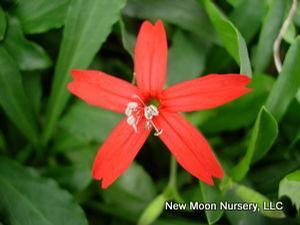New Moon Nurseries
Silene virginica
Fire pink
Native to North America
FIRST IMPRESSIONS: Silene virginica is a tufted perennial wildflower with narrow lance-shaped leaves. In spring loose clusters of scarlet red flowers similar to Phlox spp. rise above the foliage on slender stems. The floret bases are tubular and the petals are spreading with ragged edges. Plants thrive in partially sunny gardens with well drained mesic or dry soil.
HABITAT & HARDINESS: Silene virginica is native from Ontario south from New York to the Florida panhandle and west to Minnesota and Louisiana.
Plants are indigenous to rocky wooded slopes, upland forest margins, calcareous woodlands, shaded bluffs, limestone or sandstone cliffs and ledges. This species usually occurs on sloped or barren areas without an abundance of other vegetation. Plants can tolerate fire and other disturbance but will decline if the tree canopy becomes too dense.
Plants are hardy in USDA Zones 4-8.
PLANT DESCRIPTION: Silene virginica is a low mounding taprooted wildflower.
The basal leaves have petioles and are 2-6” long and 1” wide. Blades are narrowly oval but broadest toward their rounded or bluntly pointed tips. The stem leaves are arranged in pairs and are sessile and smaller than the lower leaves.
In spring clusters of brilliant 1” scarlet flowers rise above the foliage. The florets have narrow tubes that spread into 5 deeply cut petals. The calyx is covered with sticky glandular hairs.
After flowering, elongated capsules less than ½” long form. Each has an opening at the tip surrounded by 6-8 recurved teeth. The seed inside are dark brown and kidney shaped.
Flowering stems rise to 1-2’ and plants spread to 1-1.5’.
CULTURAL & MAINTENANCE NEEDS: Silene virginica grows best in partly sunny or partly shaded sites with average well drained soil.
Plants are pest resistant and tolerant of drought and poor sandy, clay or rocky soils.
This species is considered to be a short lived perennial especially if overcrowded. Plants will occasionally reseed.
LANDSCAPE USES: Silene virginica is an excellent Accent plant for a Shade Garden or Shaded Rock Garden. In residential sites, locate small Groups of plants throughout shaded areas or Mass them into a spectacular Groundcover planting. Plants provide showy Spring Flowers and are valuable components of Cottage Gardens, Water-wise Landscapes, Low Maintenance Plantings, Perennial Borders and Wildlife Gardens.
COMPANION & UNDERSTUDY PLANTS: Silene virginica mingles cheerfully with Aquilegia canadensis ‘Corbett’, Chrysogonum virginicum, Phlox divaricata and Heuchera villosa. Woodland sedges like Carex plantaginea or Carex texensis and native ferns like Athyrium filix-femina or Polystichum acrostichoides make good foliage companions.
Silene regia would be a suitable substitute in many garden situations. Aquilegia candensis could also provide red flower color in similar cultural situations.
TRIVIA: Ruby-throated hummingbirds are the principle pollinator of Silene virginica. Flowers also provide nectar for native bees, butterflies and nocturnal moths.
Silene virginica was chosen as the 2015 North Carolina Wildflower of the Year.
Silene virginica is sometimes called scarlet catchfly because of the sticky hairs on the calyx that are reminiscent of fly paper. The sticky surface deters ants from climbing to the flower to steal nectar.
This species belongs to the Pink Family (Caryophyllaceae). Family members have petals that are notched or fringed in some way. Many members of this family are called “pinks” due to the deeply notched ragged or “pinked” appearance of the petals.
Height:
1-2 ftSpread:
1-2 ftSpacing:
18-24 inUSDA Hardiness Zone:
4-8Bloom Color:
RedSilene virginica Characteristics
Attracts Wildlife
- Pollinators
- Hummingbirds
- Butterflies
Attributes
- Ground Cover
- Drought Tolerant
- Clay Soil
- Rock Garden
- Naturalizing
Exposure
- Partial Shade
Flowering Months
- June
- May
Foliage Color
- Green
Soil Moisture Preference
- Moist to Dry
Interesting Notes:
For more information on this plant, visit the USDA PLANTS Database: http://plants.usda.gov/java/profile?symbol=SIVI4
